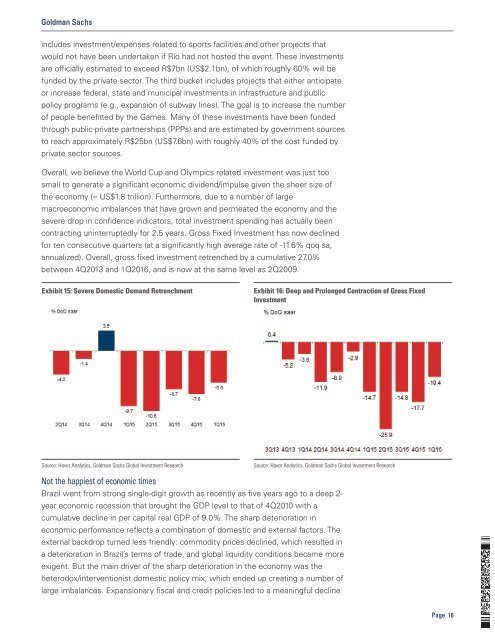You also want an ePaper? Increase the reach of your titles
YUMPU automatically turns print PDFs into web optimized ePapers that Google loves.
Goldman Sachs<br />
includes investment/expenses related to sports facilities and other projects that<br />
would not have been undertaken if Rio had not hosted the event. These investments<br />
are officially estimated to exceed R$7bn (US$2.1bn), of which roughly 60% will be<br />
funded by the private sector. The third bucket includes projects that either anticipate<br />
or increase federal, state and municipal investments in infrastructure and public<br />
policy programs (e.g., expansion of subway lines). The goal is to increase the number<br />
of people benefitted by the Games. Many of these investments have been funded<br />
through public-private partnerships (PPPs) and are estimated by government sources<br />
to reach approximately R$25bn (US$7.6bn) with roughly 40% of the cost funded by<br />
private sector sources.<br />
Overall, we believe the World Cup and Olympics related investment was just too<br />
small to generate a significant economic dividend/impulse given the sheer size of<br />
the economy (≈ US$1.8 trillion). Furthermore, due to a number of large<br />
macroeconomic imbalances that have grown and permeated the economy and the<br />
severe drop in confidence indicators, total investment spending has actually been<br />
contracting uninterruptedly for 2.5 years. Gross Fixed Investment has now declined<br />
for ten consecutive quarters (at a significantly high average rate of -11.6% qoq sa,<br />
annualized). Overall, gross fixed investment retrenched by a cumulative 27.0%<br />
between 4Q2013 and 1Q2016, and is now at the same level as 2Q2009.<br />
Exhibit 15: Severe Domestic Demand Retrenchment<br />
Exhibit 16: Deep and Prolonged Contraction of Gross Fixed<br />
Investment<br />
Source: Haver Analytics, Goldman Sachs Global Investment Research<br />
Source: Haver Analytics, Goldman Sachs Global Investment Research<br />
Not the happiest of economic times<br />
Brazil went from strong single-digit growth as recently as five years ago to a deep 2-<br />
year economic recession that brought the GDP level to that of 4Q2010 with a<br />
cumulative decline in per capital real GDP of 9.0%. The sharp deterioration in<br />
economic performance reflects a combination of domestic and external factors. The<br />
external backdrop turned less friendly: commodity prices declined, which resulted in<br />
a deterioration in Brazil’s terms of trade, and global liquidity conditions became more<br />
exigent. But the main driver of the sharp deterioration in the economy was the<br />
heterodox/interventionist domestic policy mix, which ended up creating a number of<br />
large imbalances. Expansionary fiscal and credit policies led to a meaningful decline<br />
Page 16


